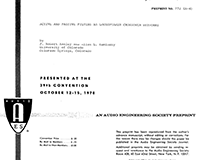I currently have a pair of active speakers, JBL LSR 308, and a pair of passives, martinLogan reQuest, in the same room, fed with the same source/dsp/DAC/preamp. I wouldn't call either one of them "the best". Good enough, maybe.
I use a miniDSP to apply a "filter" to signal going to the speakers (a different customized filter for each), to "correct" the measurement obtainedat the listening position.
As an example, here are the uncorrected (red) and "corrected" (black) "step response" measurements for each.
View attachment 10166
I'm not sure I could identify which traces belong to the active and which belong to the passive.
In either case, the correction gets them both close to looking like what "the best" would shoot for.
For casual listening, I find them rather indistinguishable. I can easily forget which is playing, and have to look at the equipment LEDs for hints. For critical listening, I prefer the MartinLogans imaging and lower distortion at higher SPL.
So, I use "Active Signal" and am currently satisfied. Have I coined a new phrase?
As a bonus, it can be applied to any speaker I bring in to play with, active, or passive.
(I'm not a "play music from my computer" type - you could perform the same magic from the PC)
(Cosmic will argue that correcting the speaker itself is better, because he can)

